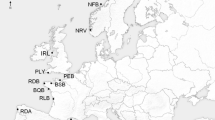Abstract
Laboratory cultures of offspring from single families and a mass mating ofMytilus edulis were reared to the spat stage at different temperatures. Some cultures were reared further to the juvenile stage at the same, or at an altered temperature. Using electrophoresis, frequencies of genotypes at theOdh, Pgm, Gpi, Hex, EsD, Pgk andDia loci were recorded at the spat stage and, again, where possible, in juveniles. Significant deviations from expected genotype frequencies were observed at most loci in at least some cultures, but in no cases were these deviations related to the temperature at which the cultures had been reared. We speculate that these differences may have been due to variations in the density of mussel spat in the cultures. Very extensive and consistentPgm genotype-specific mortalities were evident in one family, and, in another family, consistent deviations were seen at theHex locus. Weaker, but nevertheless significant, deviations from expected genotype frequencies occurred at most other loci and it is concluded that, in most cases, the loci were acting as markers for a locus, or loci, on the same chromosome which had a strong effect on fitness. It is thought unlikely that evidence for similar levels of selection would be found in natural populations because, in wild populations, particular marker-locus genotypes would be associated with a range of genetic backgrounds rather than a single chromosome.
Similar content being viewed by others
Literature cited
Adamkewicz, L., Taub, S. R., Wall, J. R. (1984). Genetics of the clamMercenaria mercenaria. II. Size and genotype. Malacologia 25: 525–533
Bayne, B. L. (1965). Growth and the delay of metamorphosis of the larvae ofMytilus edulis (L.). Ophelia 2: 1–47
Beaumont, A. R., Beveridge, C. M. (1983). Resolution of phosphoglucomutase isozymes inMytilus edulis L. Mar. Biol. Lett. 4: 97–103
Beaumont, A. R., Beveridge, C. M., Barnet, E. A., Budd, M. D. (1989). Genetic studies of laboratory rearedMytilus edulis. II. Selection at the leucine amino peptidase (Lap) locus. Heredity 62: 169–176
Beaumont, A. R., Beveridge, C. M., Barnet, E. A., Budd, M. D., Smyth-Chamosa, M. (1988). Genetic studies of laboratory rearedMytilus edulis. I. Genotype specific selection in relation to salinity. Heredity 61: 389–400
Beaumont, A. R., Beveridge, C. M., Budd, M. D. (1983). Selection and heterozygosity within single families of the mussel,Mytilus edulis (L.). Mar. Biol. Lett. 4: 151–161
Bulnheim, H.-P., Gosling, E. (1988). Population genetic structure of mussels from the Baltic Sea. Helgoländer Meeresunters. 42: 113–129
Colgan, D. J. (1987). Deficits of heterozygotes in relation to selective interactions between loci in the musselsBrachidontes rostratus andXenostrobus pulex. Heredity 59: 355–362
Fevolden, S. E., Garner, S. P. (1986). Population genetics ofMytilus edulis (L.) from Oslofjorden in oil-polluted and non oil-polluted water. Sarsia 71: 247–257
Gaffney, P. M., Scott, T. M. (1984). Genetic heterozygosity and production traits in natural and hatchery populations of bivalves. Aquaculture, Amsterdam 42: 289–302
Gentili, M. R., Beaumont, A. R. (1988). Environmental stress, heterozygosity and growth rate inMytilus edulis. J. exp. mar. Biol. Ecol. 120: 145–153
Gosling, E. M. (1979). Hidden genetic variability in two populations of a marine mussel. Nature, Lond. 279: 713–715
Hedrick, P. W. (1985). Genetics of populations. Jones & Bartlett, Inc, Boston, USA
Hvilsom, M. M., Theisen, B. F. (1984). Inheritance of allozyme variations through crossing experiments with the blue mussel,Mytilus edulis L. Hereditas 101: 1–7
Koehn, R. K., Gaffney, P. M. (1984). Genetic heterozygosity and growth rate inMytilus edulis. Mar. Biol. 82: 1–7
Koehn, R. K., Hilbish, T. J. (1987). The adaptive importance of genetic variation. Am. Scient. 75: 134–141
Koehn, R. K., Milkman, R., Mitton, J. B. (1976). Population genetics of marine pelecypods. IV. Selection, migration and genetic differentiation in the blue musselMytilus edulis. Evolution, Lawrence, Kansas 30: 2–32
Loosanoff, V. L., Davis, H. C. (1963). Rearing of bivalve molluscs. Adv. mar. Biol. 1: 1–136
Mallet, A. L., Zouros, E., Gartner-Kepkay, K. E., Freeman, K. R. (1986). Genetics of growth in blue mussels: family and enzyme-heterozygosity effects. Mar. Biol. 92: 475–482
Mallet, A. L., Zouros, E., Gartner-Kepkay, K. E., Freeman, K. R., Dickie, L. M. (1985). Larval viability and heterozygote deficiency in populations of marine bivalves: evidence from pair matings of mussels. Mar. Biol. 87: 165–172
Maynard Smith, J. (1989). Evolutionary genetics. Oxford University Press, Oxford
Parker, R. E. (1973). Introductory statistics for biology. Edward Arnold, London
Skibinski, D. O. F., Beardmore, J. A., Cross, T. F. (1983). Aspects of the population genetics ofMytilus (Mytilidae; Mollusca) in the British Isles. Biol. J. Linn. Soc. 19: 137–183
Skibinski, D. O. F., Roderick, E. E. (1989). Heterozygosity and growth in transplanted mussels. Mar. Biol. 102: 73–84
Zouros, E, Foltz, D. W. (1984). Possible explanations of heterozygote deficiency in bivalve molluscs. Malacologia 25: 583–591
Zouros, E., Romero-Dorey, M., Mallet, A. L. (1988). Heterozygosity and growth in marine bivalves: further data and possible explanations. Evolution, Lawrence, Kansas 42: 1332–1341
Author information
Authors and Affiliations
Additional information
Communicated by J. Mauchline, Oban
Rights and permissions
About this article
Cite this article
Beaumont, A.R., Beveridge, C.M., Barnet, E.A. et al. Genetic studies of laboratory-rearedMytilus edulis . Mar. Biol. 106, 227–233 (1990). https://doi.org/10.1007/BF01314804
Accepted:
Issue Date:
DOI: https://doi.org/10.1007/BF01314804




